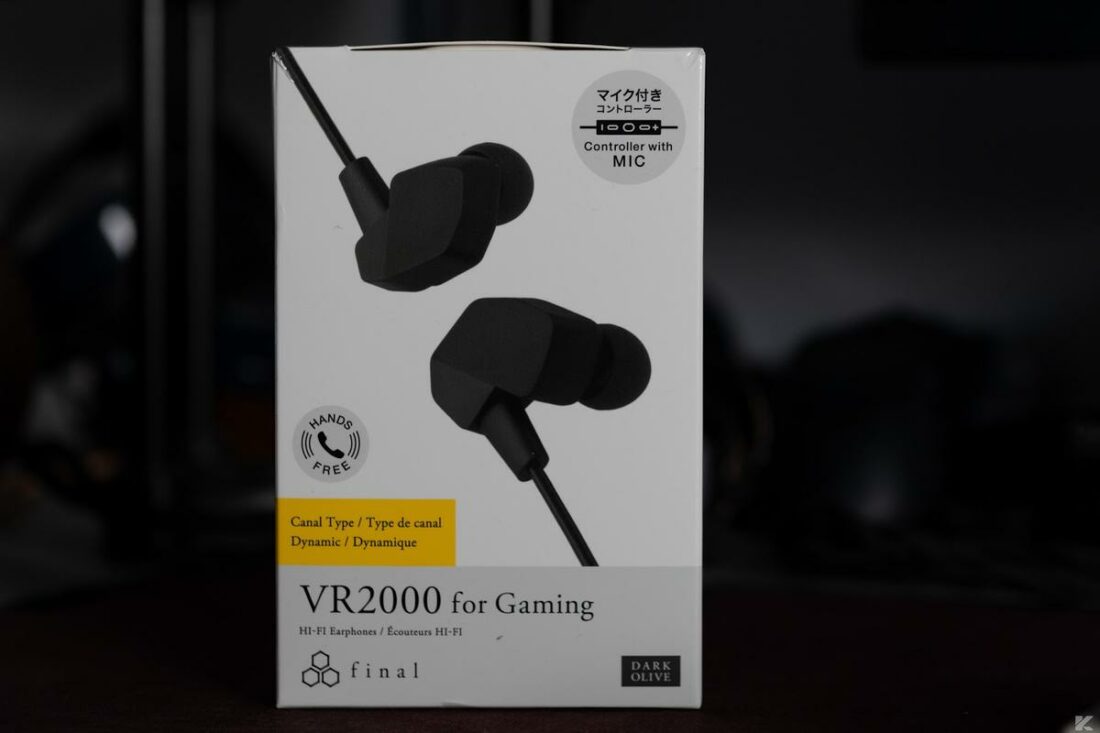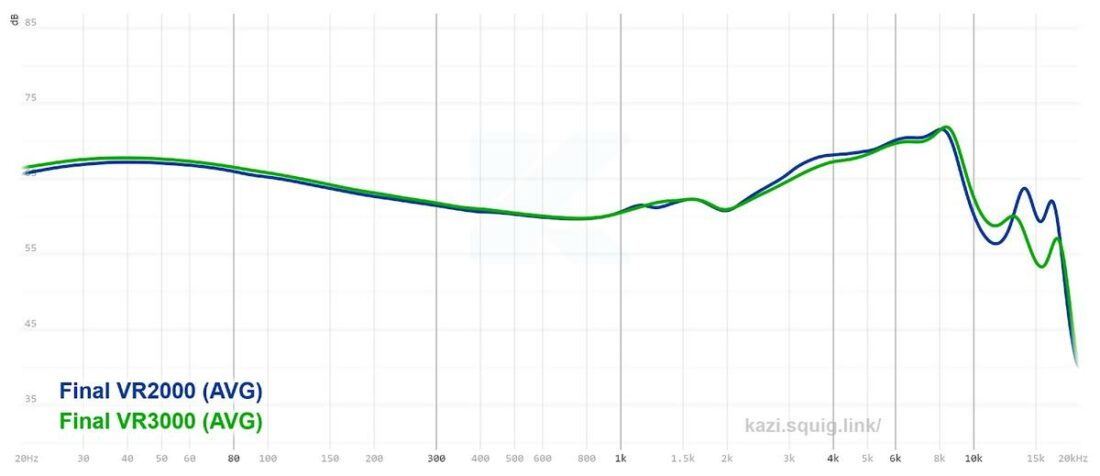The VR2000 caters to a niche, offering exceptional gaming and virtual reality performance.
- Extremely comfortable fit
- High-quality stock ear tips
- Very fast driver response
- Class-leading positional accuracy in games and binaural tracks
- Excellent end-to-end extension
- Joint stereo tracks can sound odd
- Treble can be too forward in some music
- Inline mic quality is merely average
- Fixed cable can be too short for desktop gamers
Gaming products have almost become a meme nowadays. The categorization usually alludes to overpriced, cheaply built products with glitzy lights and gaudy designs.
Fortunately, the Final VR2000 are the exact opposite of said generalization, in terms of aesthetics at least. They have a muted design language, a decent build, and are claimed to have been tuned to reproduce binaural audio as faithfully as possible.
Is all of it just marketing fluff, or are there tangible benefits in gaming and virtual reality applications? Read on.
Unboxing and First Impression
Design and Build
The Final VR2000 have a stealthy design.
Everything from the color scheme to the shape of the IEMs indicates that these are supposed to fade into the background without visually sticking out too much. The angular design was first introduced with the release of Final’s B-series IEMs and carried into the VR series.

There are two vents on the inner side of the IEMs. The nozzle is not too thin or long, just about the right size for a deep fit.
The fixed cable has some strain relief near the housing and the 3.5mm termination. There is also a small bump on the strain relief of the left earpiece, making it easy to identify the left earpiece without looking.

Overall, the design and build are solid, with the fixed cable being the biggest caveat. The ABS shell can take a beating, so it’s even more perplexing why Final chose a non-removable cable for the VR2000.
Cable
The fixed stock cable may be a deal breaker for potential buyers.
Despite its fixed nature, the cable is supple and easy to manage. The default 1.2m length is perfect for handheld devices. However, desktop gamers tend to prefer longer cables, so an option for a 1.5m cable variant would be highly appreciated.

The cable has an inline remote with playback controls. Sadly, the mic quality is only average compared to the boom mics. On one hand, there is a noticeable background hiss even in quiet environments, and in noisy environments, there is no suppression of surrounding noise.
For gaming sessions, I prefer something with omnidirectional pickup and better voice clarity.
Mic recordings
Comfort
The VR2000 are extremely comfortable for long listening sessions, thanks to the combination of lightweight shells, exceptional E-type tips, and ergonomic shape. Isolation is very good as well due to no outward-facing vents.

Under the Hood
Final VR2000 utilize a 6mm F-core DU single dynamic driver.
F-core DU is Final’s proprietary dynamic driver platform characterized by a brass driver chamber, ultra-light suspension mechanism, and an ultra-thin voice coil. The tolerances are extremely tight, which allows better driver matching.
How Do the Final VR2000 Sound?
Unlike my usual reviews, where the discussion is centered around music reproduction, the VR2000 get a dedicated Gaming and Multimedia section following the tuning analysis.
The general tuning of the Final VR2000 can be labeled as “U-shaped.”
The upper-treble and overall end-to-end extension are very uncommon for a single dynamic driver, especially at this price point.

Bass
The Final VR2000’s bass tuning is rather interesting. The slight sub-bass roll-off around 30 Hz, coupled with the very fast driver, results in bass notes that have noticeable impact and slam, but the decay is unusually quick.
Fast bass notes are reproduced well, while multiple gunshots and explosions are easy to separate. Mid-bass texture is lacking somewhat, which can lead to less-than-satisfying snare hits and double pedals.
Midrange
The midrange tuning on the VR2000 is rather unique.
There is no bass bleed thanks to the bass shelf starting from around 300 Hz downward. However, the region around 500-800 Hz is slightly recessed, which can make male vocals sound somewhat thin. Strings and pianos can also come across as higher-pitched than they are in reality.
The upper-mid is where things get even less… conventional. There is a noticeable depression around 2kHz, which is an area where many IEMs start to gain in amplitude. However, such tuning choice is not uncommon in the headphone world (look at Hifiman HE-6seV2, for example).
Such dips in the upper-mid make vocals sound distant, almost as if being projected from the front instead of being “in your head.” But then Final throws a curve ball and increases the pinna gain from 2.5kHz and up.
As a result, female voices are no longer muted. Rather they gain back some of the lost focus, while soaring male vocals do not sound dampened anymore.
On Amber Rubarth’s Tundra, this effect is on full display. The vocals are not centered in the head, rather have a frontal projection, while still having sufficient energy. The rest of the instruments play around your head, resulting in an immersive listen.
The tuning choices also result in better speech clarity and separation of backing and main vocals, but this comes at the cost of lower-mid richness and baritone vocals being robbed of their natural heft. Something’s gotta give, after all.
Treble
The VR2000 have excellent upper-treble extension for a single dynamic setup.
The mid-treble tuning can be contentious, however. Sometimes I feel that there is too much energy around 7 kHz, which can lead to discomfort if you listen at loud SPLs. This tuning is intentional once again, as it makes high-pitched sounds stand out (more on this in the following section on gaming).
Nonetheless, the treble elevation lacking distinct dips and peaks can make it more fatiguing than usual for very treble-sensitive people. I did not find it to be an issue, and with the supplied Final E-type tips the treble peakiness is well under control to my ears, but an audition is always advised.
Gaming and multimedia
This is where the VR2000 flexes their muscles. Games tend to have “3D audio,” which is a glorified buzzword for advanced DSP effects that are calculated on the fly, placing elements in the game world in distinct spots all around the listener’s perceived head stage.
The VR2000 are tuned (and even acoustically engineered) to excel at reproducing “blobs” of sound around you. In Battlefield 1, the sound of hundreds of bullets fizzing past your head is distinct, and every gunshot can be pinpointed. The aforementioned peak near 7 kHz helps in this regard.
Moreover, things happening behind you are simulated as such, while in most IEMs, they tend to be just pushed to the center. Footsteps getting closer or farther away can be immediately identified, which is a must to excel at such games.

Atmospheric games such as Hellblade: Senua’s Sacrifice and Resident Evil 4: Remake become more immersive as you become wrapped in a cocoon of sound. Frankly, if I did not have the Sennheiser HD 800 already, I would use the VR2000 as my go-to gaming choice.
But this is when I encounter my pet peeve about these IEMs: the 1.2m non-detachable cable.
The cable is not long enough for desktop or PC gaming, simple as that.
1.5m is the least you can get away with, and 2m would be adequate. For handheld gaming this length is perfect, but I expect Final to consider desktop gamers as well.
Even though I have my desktop DAC placed in front of me, many gamers I know tend to use the headphone jack on the top of their PC case. Moreover, the sudden movements many make while gaming can tug at the cable if there is not enough slack.
If the VR2000 had a detachable cable, this would be a non-issue for me, as I could just order a custom-length cable. Sadly, that’s not an option here, and you are stuck with the short cable. You can always go for a 3.5mm to 3.5mm extension cord, but in my experience, those tend to ruin the sound.
So, for gaming, I have zero qualms about the VR2000’s performance in terms of sound, but in terms of practicality, there are compromises that are not immediately apparent, namely the short cable length and subpar mic performance.
Comparisons
Final VR2000 vs Final VR3000
Final VR3000 were the first IEMs in the VR series and are also geared towards gaming. They have a similar shell design to the VR2000, the same fixed cable, and the same accessory set.
Ironically, even the graphs are twins, well, until you get into the upper-treble. So, what’s changed, or is it just Final trying to pull a fast one on us by repainting the shell in olive green and calling it a day?

Well, not really. Graphs do not tell the whole story. The bass, for one, is slower on the VR3000, and the resolution, in general, is noticeably improved on the VR2000. The treble is airier on the VR2000 while staging and imaging are further improved.
As a result, for gaming, I much prefer the VR2000 over their predecessors. If gaming is your primary concern, get the VR2000 and call it a day.

However, the VR3000 sound warmer with denser bass response, which I find to be a better fit for watching movies, listening to podcasts, and even certain binaural tracks. Technically, the VR2000 are superior, but the boosted clarity may get tiring, and that’s when the VR3000 come in.
However, such cases are rare, so I’d suggest picking the VR2000 if anyone is confused between the two. Not that there are many other proper “gaming” IEMs out there anyway.
Where to Buy
Who Should Buy This?
The VR2000 are great for professional and casual gamers looking for the utmost positional accuracy within a budget and those looking for faithful reproduction of binaural audio but are not the best option for joint stereo music tracks.
Final Thoughts
Final VR2000 are specialists by nature. They excel at binaural and 3D audio playback, and their ability to pinpoint gunshots and other events happening during gameplay is class-leading by a comfortable distance.
This also means that they are a bit hamstrung when it comes to playing joint stereo tracks. The usual music sounds alright but the staging and imaging feel off and diffused. The quick sub-bass decay might also rob some rumble off of tracks.
In the end, the VR2000 are meant to be part of a larger collection and should not be used as your only pair of IEMs. Once you manage your expectations accordingly and use them primarily for the tasks they were built for – you will be in for a pleasant surprise.
I am keeping the VR2000 in my permanent collection for gaming on the go, and anyone with a Steam Deck or Switch should try to get their hands on a pair.
Company Overview
Established in 1974, Final Audio is a Japanese audio brand that is a part of S’NEXT Co., Ltd. Based out of Kawasaki, Final excels at experimental designs and the offerings range from ultra-budget to summit-fi.
What’s in the Box?
- Final VR2000 IEMs
- Carrying pouch
- Ear guides
- 5 pairs of Final E-type tips
Technical Specifications
- Form: IEMs
- Driver: 1 x Dynamic driver
- Impedance (Ohm): 18 ohms
- Sensitivity (dB): 102 dB/mW
- Weight (g): 20g
- Frequency Response (Hz): N/A
- Removable Cable: N
- Source Jack: 3.5mm
- Cup/Shell Jack: N/A
